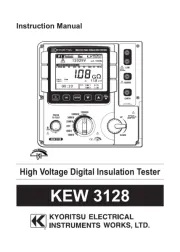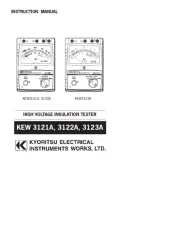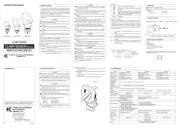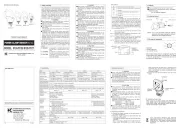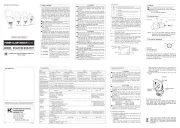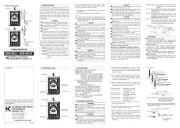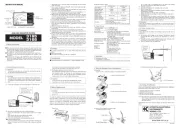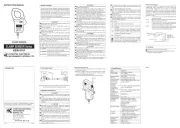
4. PIN ASSIGNMENT FOR OUTPUT TERMINAL
The pin assignment for the output terminal of this clamp sensor is as
* Pin assignment at the connecting terminal of measuring instrument
is symmetrical to above figure.
● Output signal passes between 3 and 5 of Output terminal.
● This clamp sensor is supplied power via an Output cable. Power
supply of +3.0 to +5.5V is required between 1 and 3 of Output
terminal and -3.0 to -5.5V is required between 2 and 3 of Output
● Never attempt to make any measurement if any abnormal
conditions, such as a broken cover or exposed metal parts are
present on the clamp sensor.
● Do not disassemble, install substitute par ts or make any
modification to the clamp sensor. Return the clamp sensor to
your local KYORITSU distributor for repair or re-calibration in
case of suspected faulty operation.
● Do not use the clamp sensor if the clamp sensor or your hands
are wet. Otherwise, electrical shock accident may occur.
● Use insulated protective gears for your safety when using this
Do not step on or pinch the cord; it may damage the jacket of cord.
Do not expose the clamp sensor to direct sunlight, high temperatures,
humidity or dew. Otherwise, it may cause deformation or insulation
degradation and cannot meet the original specification.
● Not to give shocks, such as vibration or drop, which may
damage the clamp sensor, during transit or use.
● Use a damp cloth with water or neutral detergent for cleaning the
clamp sensor. Do not use abrasives or solvents.
● This clamp sensor is not designed to be dust or waterproof. Do
not use it dusty places or where the clamp sensor is likely to be
wet. It may cause troubles on the clamp sensor.
● Never pinch foreign matters or give vibrations at the jointed
parts of this clamp sensor. Otherwise, matching area of Jaws
may be damaged and cause influences on the measurements.
● Do not bend or pull the root of the cable in order to prevent
● Never apply the current exceeding the measuring range for a
long time. It may damage the clamp sensor.
● Never connect/remove the connectors while connected devices
are on or clamping onto the conductor under test. Otherwise, the
connected devices or clamp sensors may be damaged.
● Accurate measurement may not be obtained in the vicinity of
strong magnetic fields such as transformers, high-current
circuits or wireless machines.
Meaning of symbols on the clamp sensor:
User must refer to the explanations in the instruction manual
Clamp sensor with double or reinforced insulation
Do not apply around or remove from un-insulated hazardous
live conductors, which may render electric shock, electric
Crossed-out wheel bin symbol (according to WEEE Directive:
2002/ 96/ EC) indicating that this electrical product may not
be treated as household waste, but that it must be collected
Cautions for using this clamp sensor with KEW5010/5020:
Some KEW5010/5020 that were manufactured before the specific
timing of production may not be used with this clamp sensor. Please
refer to 6-3 Connecting with Logger (KEW5010/5020) and
This clamp sensor has been designed and tested according to
IEC61010-1: Safety Requirements for Electronic Measuring Apparatus,
and delivered in the best condition after passing quality control tests.
This instruction manual contains warnings and safety rules which have
to be observed by the user to ensure safe operation of the clamp
sensor and to maintain it in safe condition. Therefore, read through
these operating instructions before using the clamp sensor.
● Read through and understand instructions contained in this
manual before starting to use the clamp sensor.
● Keep the manual at hand to enable quick reference whenever
● The clamp sensor is to be used only in its intended applications.
● Understand and follow all the safety instructions contained in
It is essential that the above instructions are adhered to. Failure to
follow the above instructions may cause injury, clamp sensor
damage and/or damage to equipment under test. KYORITSU is not
liable for any damage resulting from the users mishandling of the
The symbol # indicated on the clamp sensor means that the user
must refer to the related parts in the manual for safe operation of the
clamp sensor. It is essential to read the instructions wherever the #
symbol appears in the manual.
# DANGER: is reserved for conditions and actions that are likely
to cause serious or fatal injury.
# WARNING: is reserved for conditions and actions that can
cause serious or fatal injury.
# CAUTION: is reserved for conditions and actions that can
cause injury or instrument damage.
● With attention to the measurement category to which the object
under test belongs, and do not make measurements on a circuit
in which the electrical potential exceeds the following values:
300V for CAT IV and 600V for CAT III or lower categories.
To ensure safe operation of measuring instruments, IEC 61010
establishes safety standards for various electrical environments,
categorized as O to CAT IV, and called measurement categories.
Higher-numbered categories correspond to electrical environments
with greater momentary energy, so a measuring instrument designed
for CAT III environments can endure greater momentary energy than
O : Circuits which are not directly connected to the mains
CAT II : Electrical circuits of equipment connected to an AC
electrical outlet by a power cord.
CAT III : Primary electrical circuits of the equipment connected
directly to the distribution panel, and feeders from the
distribution panel to outlets.
CAT IV : The circuit from the service drop to the service entrance,
and t o th e po wer mete r and primar y over-c urrent
protection device (distribution panel).
● This is a Clamp Sensor capable of measuring AC current up to
● Flexible and light weight because of an air core coil used at the
Output voltage AC500mV/AC1000A(0.5mV/A)
Measuring range AC0 - 1000Arms(1850Apeak)
±0.8%rdg±0.2mV(45 - 65Hz)
±1.5%rdg±0.4mV(40 - 1kHz)
Phase characteristics 45 to 65Hz: within ±2°
range (guaranteed accuracy)
23±5ºC, Relative humidity: 85% or
-10 to 50ºC, Relative humidity: 85% or
-20 to 60ºC, Relative humidity: 85% or
Max allowable input AC1300A (continuous)
Output impedance 100Ω or less
Environmental condition Altitude up to 2000m, in-door use
Applicable standards IEC 61010-1
Measurement CAT III(600Vrms), CAT
Environmental standards EU RoHS directive compliant
Withstand voltage AC5160V (r.m.s. 50/60Hz) / 5 sec.
Between circuit – clamp sensor
Insulation resistance 50MΩ or more/ 1000V
Between circuit – clamp sensor
Measureable conductor size Max ø 110mm
Cable length Between clamp sensor – circuit box:
Between circuit box – output terminal:
Output terminal MINI DIN 6PIN
Accessories Instruction manual
Cable marker: No.1 to 3 (2pcs each)
Carrying case (MODEL9095)
6. OPERATING INSTRUCTIONS
● With attention to the measurement category to which the object
under test belongs, and do not make measurements on a circuit
in which the electrical potential exceeds the following values:
300V for CAT IV and 600V for CAT III or lower categories.
● The measurable conductor size is max. 110mm in diameter.
Accurate results cannot be obtained if the clamp sensor is not
● When disconnecting the output terminal from the measuring
instrument, do so by removing the plug first and not by pulling
(1) Connect the output terminal to the input terminal on the
(2) Power on the measuring instrument.
(3) Press the Joint according to the following illustrations and
Clamp onto one conductor under the test. Locate the conductor
to the position as shown in the below figure. When connecting
the Clamp sensor with our Power meter (MODEL6315 etc.),
check the direction of the Guide arrow mark indicating the
current flowing direction marked on the Joint of the Clamp
sensor to make the phase of the current under test and output
(5) Confirm that the Joint on the Clamp sensor is firmly locked.
● Jointed part of the Clamp sensor may be disconnected if
excessive force is applied to.
● Clamp onto one conductor only; measurements cannot be made
when clamping single-phase (2-wire) or three-phase (3-wire) at
Connecting with Power meter (KEW6315/KEW6310/KEW6305/
When this clamp sensor is detected by the auto-detection function
of our KEW6310/ 6315 Power meter after the connection, the type
of the clamp sensor will be displayed as follows. On KEW6310, the
displayed model name will not be KEW8130, however, this is
not a malfunction. Enter the model name according to the following
table if setting the type of the clamp sensor directly.
Power meter Model name displayed through
the auto-detection function
● MODEL6300/ KEW6305 does not detect the connected clamp
sen sor s automatic ally. Enter t he mod el name direc tly:
● For the detailed setting of the clamp sensor, please refer to the
instruction manual for each Power meter.
6-3 Connecting with Logger (KEW5010/5020)
When using this clamp sensor together with our KEW5010 / 5020
(1) Connect the clamp sensor to
CH1 of KEW5010/ 5020 while
KEW5010 / 5020 is in powered
(2) The n pow er on K E W5010 /
5020. Time will be displayed,
will be displayed. (KEW5010/
5020 checks the connected
c l a m p s e n s o r s w he n i t is
powered on, and detects and
dis pl ays t he c lam p se ns or t y pe a nd a pr op er r an ge
(3) Now the instrument is ready for
connection) is displayed on the
LCD; it means no clamp sensor is
connected to the selected channel
or the connection is loose.
In this case, check the connection and reconnect the clamp
sensor,and power off KEW5010 / 5020. Then power it on again.
* Only KEW5010 / 5020 which have the following or later serial
number may be used with this clamp sensor.
KEW5010: No.8031560 or later
KEW5020: No.8029792 or later
POWER CLAMP SENSOR Series
Kyoritsu reserves the rights to change specifications or designs
described in this manual without notice and without obligations.
3.0 to 5.5V 3.0 to 5.5V - -
Reference test position of the conductor
